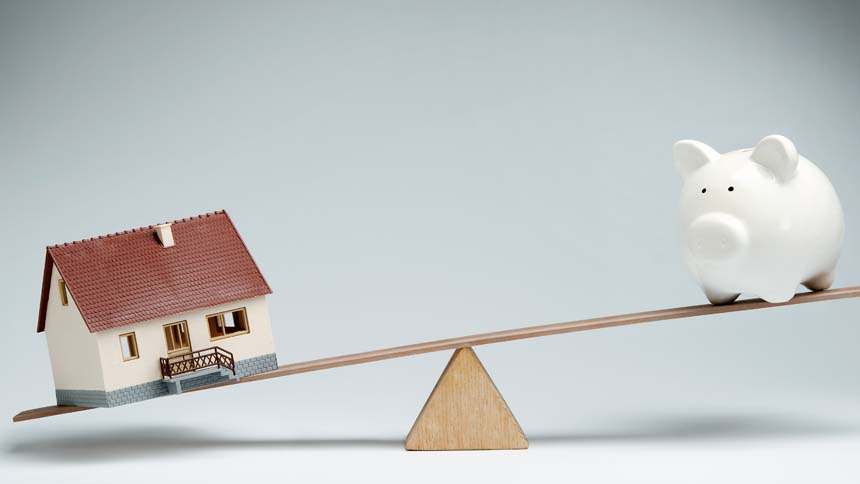Four in five of us would prefer to own our own home rather than rent, according to the Council of Mortgage Lenders (CML).
However, with house prices continuing to rise much faster than earnings and lending criteria tightened following the 2008 financial crisis and subsequent mortgage market review which led to lenders demanding bigger deposits, it remains very difficult for most people to be able to afford a property.
The latest Halifax House Price index for December 2016 shows that the average UK house price went up by nearly £4,000 or 1.7% in December to a new all-time high of £222,484. This means the average home now costs 5.81 times the average salary, almost at its all-time high of 5.83 in July 2007, just before the financial crisis.
So, how exactly can you go about raising the required deposit?
Saving for a deposit
 Most first-time buyers are expected to find a deposit of 20% of the asking price of the property they want to buy. With average house prices at their current level that is equivalent of finding £44,000, difficult to say the least.
Most first-time buyers are expected to find a deposit of 20% of the asking price of the property they want to buy. With average house prices at their current level that is equivalent of finding £44,000, difficult to say the least.
This is why the Bank of mum and dad has become increasingly important for many people, with parents either helping out towards the deposit or acting as guarantor for the mortgage repayments.
To work out how much of a deposit you need, come up with a house price you can afford that is realistic for the area you live in and house type you want. Then research what type of mortgage you are able to get in terms of loan-to-value (LTV), the percentage you need to borrow of the property asking price.
If the property you want costs £200,000 and you think you will be able to get a 90% LTV mortgage, then you must find £20,000 for the deposit.
There are other options to consider if you think saving for a full deposit is out of reach. These include Help to Buy and shared ownership.
So, there are still plenty of opportunities to buy a new home with a smaller deposit. However, with rents rising and inflation forecast to go up in 2017, it will remain a challenge to save up the required deposit.
Here are 10 top tips that you can follow to help you save for a deposit for a new property:-
1) Budget
It’s not a fun subject, but it is a very useful tool anytime but particularly at the start of a year and as a starting point for reaching the ultimate goal of saving the necessary funds for a deposit on a new home.
Setting a budget involves working out your total household income and applying it to your essential bills. Work out what you have left for discretionary spending and saving.
Saving a deposit for a new home requires focus and sacrifice so within your budget identify costs you can forego. Look at where you can cut back and if you have any standing orders and direct debits that you no longer use and cancel them.
Pare back costs further by deciding what you really can’t do without and what you can sacrifice for a year or so. Check to see if you can switch and save on insurance policies, gas and electric deals and broadband and phone costs.
However, make sure your budget is realistic. Saving for a deposit takes a long time so you can’t cut back on everything and you could give yourself a monthly reward for meeting your budget.
2) Review your market
Knowledge is king and when you are trying to save up for a deposit you need to know the expected cost of your new home in the area you want to live in.
Factor in how much it is likely prices will have risen by the time you have saved your deposit. If the house price is £200,000, add on 5% a year, which means if it takes three years, you can expect the price to have risen to around £230,000. This means a 15% deposit is now £34,500 rather than £30,000.
Of course prices could rise faster than that but they could also go up by less or even fall meaning you could reach your deposit goal quicker than expected.
You also need to factor in other costs such as mortgage fees, conveyance fees, survey fees, Land Registry fees and stamp duty and other moving costs. So research them and add them to the savings goal.
3) Work out a schedule
Once you have worked out how much deposit you need, plan how you will achieve your goal. Calculate your household income and essential spending on mortgage/rent, utility bills, food, petrol and travel expenses etc and compare income to expenditure.
Hopefully there will be money left over. Work out how much you can save on a regular monthly basis. Then work out how much you need for the deposit and when you need it by. If you need £20,000 in three years’ time, you will need to save £556 a month. If, for instance you can only save £300 a month, then you will need to adjust your timings to plan on buying in just over five years’ time.
4) Choose a savings account
 If you need to save over a long period of time, more than two years’, you could consider opening a savings bond which will pay a higher rate of interest on your savings in exchange for not having instant access to the funds. This may be a good thing though as not being able to access the savings will stop you spending it and your fund dwindling.
If you need to save over a long period of time, more than two years’, you could consider opening a savings bond which will pay a higher rate of interest on your savings in exchange for not having instant access to the funds. This may be a good thing though as not being able to access the savings will stop you spending it and your fund dwindling.
If you think you may need access to the fund in case of emergencies there are savings accounts that allow one or two withdrawals each year without penalty or losing interest.
Generally, the longer you tie your funds up for, the higher rate of interest you will get. So, a five-year savings bond pays a higher rate of interest than a three-year one.
Use a comparison website to find out the best savings options. Remember comparison sites do not all give the same result, so check two or three before deciding.
Set up a regular monthly payment from a current account to automatically transfer a regular monthly amount to your savings account.
Review your savings account each year to check what interest you are getting. Savings rates are currently very low and many of the best rates are mostly formed of a bonus that ends after one year, so review your savings deal annually and switch to a better deal if you can.
Saving into a cash ISA allows you to earn interest tax-free. The allowance you can deposit annually is currently £15,240 and this is reviewed at the start of each financial year every April.
In April 2017 the Lifetime ISA is set to be launched which will offer a similar format, so either option could be perfect for first-time buyers.
5) Stop renting
The cost of renting is often as much or more than the cost of a mortgage so it is very difficult to put money aside. It’s a difficult decision but if you want to get your own property, you may have to decide whether you can live without your own space for a while and consider alternatives.
These include returning home to live with your parents or moving in with friends. This may be a big sacrifice but if you put the money you save on rent into your savings you will reach your goal a lot quicker. Alternatively, you could try and find a cheaper room if moving back with your parents is not an option.
6) Help to Buy
The government’s Help to Buy scheme allows first-time buyers to buy a new home with a deposit of just 5% and the government or developer lend you up to a further 20%, interest-free for the first five years. It is only available for new-build homes. Find out full details here.
It has helped around 220,000 people buy a property including 180,000 first-time buyers in the last three years. Even though the mortgage guarantee element of the scheme ended on 31 December, 2016, part of its aim, to increase the number of mortgages that require a smaller deposit available, has been met.
Data from consumer group Which? shows that at the start of January 2017, there were still 257 products available for buyers with just a 5% deposit, 479 for those with a 10% deposit and 490 for buyers who can afford a 15% deposit. These figures are much higher than they were three years ago when Help to Buy was launched.
7) Get a lodger
If you have the space this can be a very good way to increase your income and put the money towards your deposit savings.
You will need to check with the landlord of the property that they are happy for you to sub-let a room. They may ask for a combined higher rent because of the extra tenant but this should still save you money and also you will both benefit from savings by splitting household bills.
You can advertise a room for rent or ask friends, colleagues or family to move in. Often, renting a room to someone you know is a good option as you are more likely to get on with them.
8) Use the bank of mum and dad
 Although not an option for most people, if your parents can help they may give or lend you some money to help towards the deposit.
Although not an option for most people, if your parents can help they may give or lend you some money to help towards the deposit.
You can discuss the terms of the loan with your parents and decide how and when you will be able to repay the money and whether interest would be added to the loan.
Most parents understand the difficulty ‘generation rent’ face with house prices out of reach for many younger people even if they have a pretty good job. Many parents want to help children pay towards owning their own home if they can, rather than paying money to landlords with no return on the outlay.
9) Shared ownership
If saving for a deposit for a whole property is unsuccessful you could use a smaller deposit to buy a share in a property.
Find out more about shared ownership
Shared ownership is open to first-time buyers and those returning to the property market after a change in circumstances. It allows someone to buy a portion of a home and pay rent on the rest, often from a housing association. Staircasing allows the homeowner to buy more of the property as they can afford to, increasing the amount they own from say 25% to 50%.
You still need a deposit, but as you are only buying 25%, 50% or 75% of the property, the level of deposit required is lower.
Example: To get a 90% mortgage on a 50% share of a property with an asking price of £200,000 means you would only need a deposit of £10,000 instead of £20,000 which would be the required deposit amount on the full property.
10) Get a guarantor
If the bank of mum and dad is shut, there could be other options to help you get a mortgage. A guarantor is able to effectively insure your mortgage repayments.
Getting someone to become a guarantor means asking them to use their property as a guarantee for your mortgage or having them put a cash lump sum into a savings account linked to your mortgage, so, you need to have a very strong relationship with them, which means it is usually other relatives or very close friends who will do this.